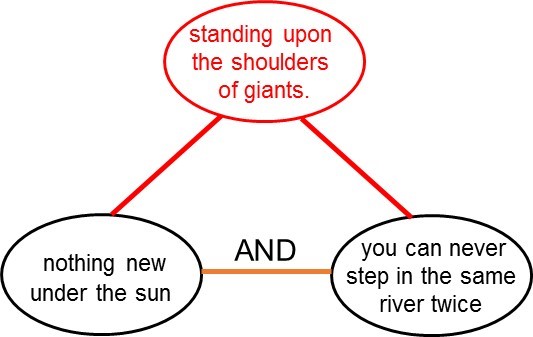I love aphorisms. I love them because they’re like little nuggets of truth. I also love them because, no matter what the situation you find yourself in might be, you can always find something to suit the mood. One of the reasons that’s possible is, if you look a little deeper, for every aphorism saying one thing, you can always find another saying the polar opposite. Aphorisms, in other words, contradict one another.
And if there’s anything I love more than aphorisms its contradictions. Contradictions lay at the heart of innovation. Innovation is pretty much all about solving contradictions: finding two conflicting truths and uncovering a higher level truth that allows both the original truths to hold true. So sayeth Hegel in his thesis-antithesis-synthesis model, back at the beginning of the 19th Century.
Which all goes to show there is nothing new under the sun. One of my favourite aphorism.
Here’s another one: ‘you can never step in the same river twice’.
Taken together, I think they make an elegant example of a contradictory pair: one says that everything is new, the other says nothing is. So how can they both be true? And if they are representative of a thesis-antithesis pair, what might the synthesis look like?
One of the most effective ways to try and solve this kind of puzzle (he would say this wouldn’t he?) is to construct one of the Systematic Innovation ‘Contradiction Maps’. Here’s what I think it might look like for this pair of aphorisms:
Looking at this picture as a whole, per its intended function, presents us with a variety of different ways to try and either solve the contradiction or challenge the underlying assumptions that connect each of the bubbles. We get a good clue from looking at the physical contradiction ‘look to the past and don’t look to the past’. We get another one by thinking about the left-hand side of the Map and what ‘successful outcome’ might mean. What’s the successful outcome we’re looking for that would come if both the aphorisms are true?
I think the answer to that question has something to do with learning from the past (not re-inventing the wheel), but simultaneously being able to apply it to solve a problem in a future that will inevitably be unique.
Taking this idea a step further, I think an aphorism that successfully synthesizes a solution to this past/future thesis-antithesis pair is Sir Isaac Newton’s saying, ‘If I have seen further than others, it is by standing upon the shoulders of giants.’ In other words, looking to the past is about working out which giant’s to go and stand on, and not looking to the past, is about standing on those shoulders and looking in to the (unknown) future.
In other words again, I would say that Newton’s aphorism sits at a higher level to the other two:
Which possibly makes it some kind of ‘meta-aphorism’?
All of which makes me wonder whether it might be possible to repeat such a thesis-antithesis-synthesis trick for every pair of contradicting aphorisms. That’s a piece of research I’d love to see. What intrigues me most about this is whether – per this example – we end up with a meta-aphorim pyramid, on the top of which sits the ‘ultimate’ aphorism, the one that explains life, the universe and everything. Or whether we end up, like a benzene ring, working our way in a gentle arc back to where we started. Do all the aphorims of the world form a hierarchy or a circle? I think we need to know.


